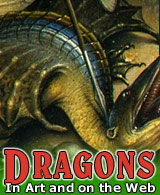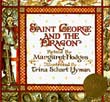
Saint George and the Dragon
This section has its own picture gallery.
About Saint George and the Dragon | Texts | Art and art discussion | Prayers | Margaret Hodges, Saint George and the Dragon | Miscellaneous | Eponymous
About Saint George and the Dragon
1913 Catholic Encyclopedia: St. George and the Dragon. Lengthy and detailed account, with a good summary of the ancient evidence and its problems, and much on the English tradition.
The Cult of Saint George by David Woods, a Classics professor at University College Cork, Ireland. His Saint George material includes an interesting piece on The Origin of the Cult of St. George. Woods develops the theory that the Palestinian and Orthodox soldier-martyr George was in fact the Cappadocian, Arian bishop George of Alexandria[1], charred relics of whom were spirited to safety after his martyrdom in Egypt. (The case is similar to Andrew Chugg's assertion that Alexander the Great lies in Saint Mark's in Venice.) The essay aside, Woods assembles three early (ie., pre-dragon) Coptic texts translated by Budge, and one Greek and one Ethiopic translated by Woods. The latter two, dealing with Christian attitudes to Islam, are exceedingly interesting. Woods has also compiled a diverse selection of other source selections, and an excellent scholarly bibliography.
Saint George in English History by Michael Collins, a book-length examination of St. George in English history, culture and national identity. The site is plagued with major and minor HTML problems, but bear with it. Start with A quick guide to facts. Larger issues of patriotism and identity are discussed in Heritage and Identity:
"So much of the history of England is bound up with the tradition of St George as received and retold among the English people that it is right to reconsider what that tradition may have to say to us today at a time of national anxiety about fundamental political and social change."The origin of St. George is covered in scholarship.
A survey of St. George in British history and culture, by Michael Collins, Oxford MPhil (from Britannia). This detailed, insightful article surveys St. George's cult chronologically, with particular reference to England. These quotes caught me eye:
"George was adopted as the patron saint of soldiers after he was said to have appeared to the Crusader army at the Battle of Antioch in 1098."
"As early as 496, Pope Gelasius in De libris recipiendis includes George among those saints 'whose names are rightly reverenced among us, but whose actions are known only to God'."
Wikipedia: Saint George. Decent article, but religious myth is hard for amateurs to get right.
Catholic Online's Saints and Angels: St. George. Brief. Hortatory.
Texts
The Cult of Saint George by David Woods (described above).
Pages from D. L. Ashliman's estimable "Folklore and Mythology Electronic Texts":
- Saint George Legends from Germany and Poland translated by Ashliman
- From Thomas Percy's
Reliques of Ancient English Poetry, stirring stuff.
"Thus did the dragon every day
Untimely crop some virgin flowr,
Till all the maids were worn away,
And none were left him to devour." - Abstract from The Golden Legend in Caxton's translation
- A short, Palestinian Christian folktale
The Life of Saint George from Caxton's translation of Jacobus de Voragine's The Golden Legend..
Wikipedia: Georgslied, 9c. Old High German poem about St. George. Original text available through Wikisource.
The Life of Saint Theodore of Sykeon, translated by Elizabeth Dawes. Contemporary life of the 7th-century saint, illustrating early devotion to Saint George.
An Old Nubian Martyrology of St George from Michael Collins' Saint George in English History.
Art and art discussion
![]() Short audio discussion of a mid-15th c. St. George and the dragon. The discussion is good, if basic, as far as it goes. But the Getty's refusal to provide large images compromises the effort. When the narrator calls attention to the "thin gold line" at the border of St. George's cloak, we don't see it. The same goes for other details. The audio descends from a page on the exhibit
Fit for a King: Courtly Manuscrits, 1380-1450, now past.
Short audio discussion of a mid-15th c. St. George and the dragon. The discussion is good, if basic, as far as it goes. But the Getty's refusal to provide large images compromises the effort. When the narrator calls attention to the "thin gold line" at the border of St. George's cloak, we don't see it. The same goes for other details. The audio descends from a page on the exhibit
Fit for a King: Courtly Manuscrits, 1380-1450, now past.
![]() Teachers' Notes for Uccello's 'Saint George and the Dragon'" from the National Gallery, London.
Teachers' Notes for Uccello's 'Saint George and the Dragon'" from the National Gallery, London.
Nineteen images of St. George and the Dragon from the National Library of the Netherlands (Icon class 11H(GEORGE)41).
![]() "Saint George and the Dragon" animated film, by the third year students at Bangabandhu Primary School, East London. Also
continued and
about the film.
"Saint George and the Dragon" animated film, by the third year students at Bangabandhu Primary School, East London. Also
continued and
about the film.
St. George coins from Prof. David Woods' Saint George pages.
New York Public Library Subject Search: "Saint George." Two images.
Saint George stamps from Scouts on Stamps Society International .
Prayers
Latin hymn to Saint George from the Burnet Psalter (15c), Aberdeen University Library.
Prayer to St. George (in Dutch?) with St. George Slaying the Dragon, from a Book of Hours and Prayer Book, (Netherlands, c. 1375-1400)
Margaret Hodges, Saint George and the Dragon
 Amazon. Saint George and the Dragon, retold by Margaret Hodges (ages 4-8).
Amazon. Saint George and the Dragon, retold by Margaret Hodges (ages 4-8).
Short review by Eliza Fegley, Sacred Spiral.
Inept analysis of Margaret Hodges's "Saint George and the Dragon" by Jeb Barnett.
Summary Margaret Hodges's "Saint George and the Dragon."
Lesson plan based on Hodges' "St. George" from The Children's Museum of Indianapolis.
Another lesson plan based on the book, this time involving building a dragon, from Matt Buchanan's ChildDrama.com.
Miscellaneous
St. George, Patron Saint of Scouting (Did you know that? I didn't.) Lewis P. Orans explains the connection, and has an excellent side-page on St. George in Russia, with icons from the Novgorod State University in Russia.
Eponymous
The Order of St. Michael and St. George, an official page from the British Monarchy.
On the Bavarian "Royal Military Order of Saint George," established in 1728.
List of contemporary churches, named after St. George, compiled by David Woods, from his Saint George pages.
St. George Coptic Orthodox Church, British Columbia, Canada.
St. George Anglican Church, Haliburton, Ontario.
St. George Illawarra. Australian Rugby team.
The Patriarchal Church of St. George, Istanbul.
Saint George Sport Association. Ethiopian soccer team.
All material © 2000–2005 Tim Spalding (contact)
Books presented in association with Amazon.com.
If you enjoy this site you may like this other site by me:
Mermaids on the Web. Similar site, with over 1,320 pictures .
Angels on the Web. Images and other web resources on angels in Western culture, religion and art.
Griffins in Art and on the Web. Like this site, but Griffins.